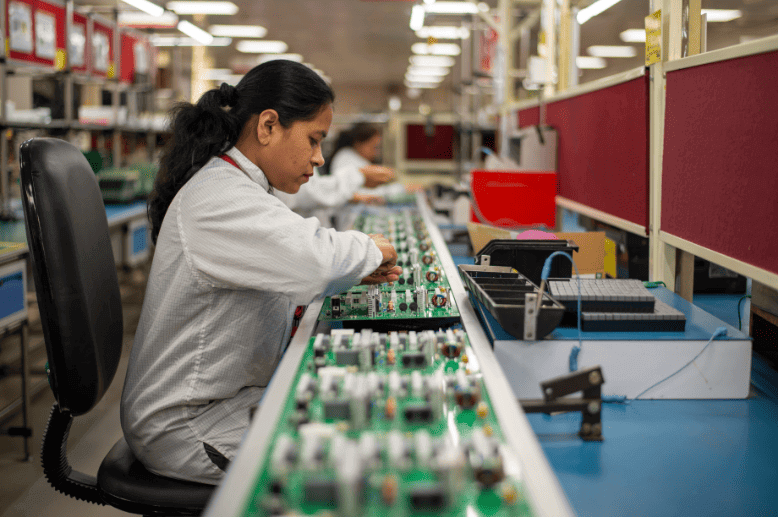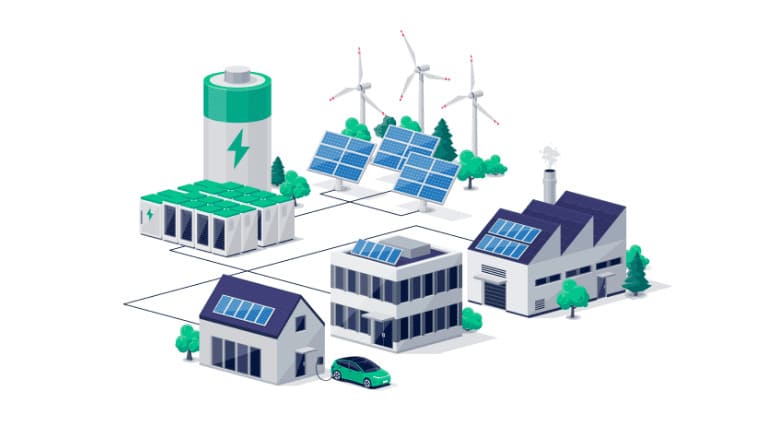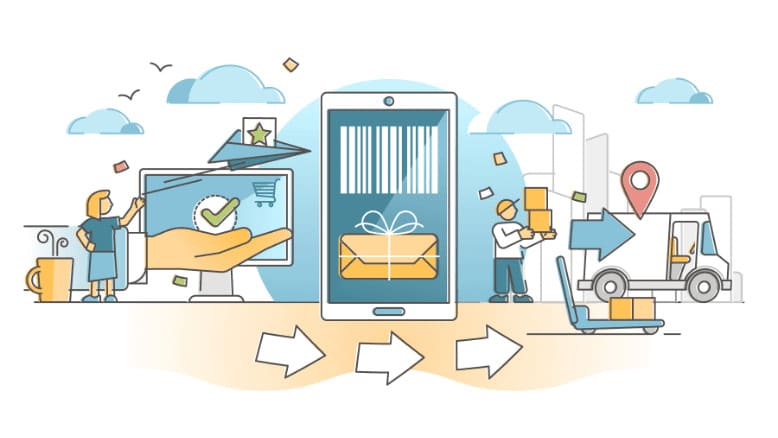Survey Says, India preferred destination for U.S. Supply Chains amid concerns over China

Survey Says, India preferred destination for U.S. Supply Chains amid concerns over China
As global supply chain dynamics continue to evolve, U.S. enterprises are increasingly viewing India as a more favorable option compared to China. This shift is largely driven by the perceived risks associated with China as a manufacturing and supply hub. A survey conducted by the UK market research firm OnePoll, involving responses from 500 U.S. executive-level managers, highlights this growing trend: a strong liking for India in the world of supply chain operations.
The findings are telling: 61% of executives would opt for India over China if both countries offered comparable manufacturing capabilities, and 56% express a preference for India to meet their supply chain needs within the next five years. Furthermore, the survey points to significant concerns about the risks of sourcing from China, with 59% of respondents labeling it as somewhat or very risky, compared to 39% for India.
The inclination towards India is not just about shifting away from China to avoid tariffs but reflects a broader strategic realignment. Enhanced U.S.-India relations, furthered by initiatives like President Joe Biden’s “friendshoring” policy, aim to reduce dependency on China by diversifying supply chains. These strengthened ties were evident during key diplomatic engagements and the signing of multiple deals across defense, technology, and supply chain diversification.
One notable example of this shift is Walmart, the world’s largest retailer, which is significantly increasing its imports from India while reducing its reliance on Chinese products. According to data from Import Yeti shared with Reuters, Walmart is diversifying its import portfolio to include a wide array of goods from India such as toys, electronics, bicycles, pharmaceuticals, packaged food, dry grains, and pasta. The strategic decision is driven by cost-cutting measures and the aim to bolster supply chain resilience, leveraging India’s growing workforce and technological advancements.
Investment momentum in India is also on the rise. Notable examples include Maruti Suzuki’s announcement of a $4.2 billion investment in a second factory and VinFast’s plan to invest about $2 billion in setting up a manufacturing facility in India. Despite this optimism, U.S. firms remain cautious, especially concerning quality assurance, delivery risks, and intellectual property security, which are seen as significant challenges.
The reality of completely transitioning away from Chinese supply chains is complex. China will continue to be a key player due to its established role in global supply strategies. Meanwhile, Vietnam also rises as a viable alternative under the “China plus one” strategy, though it doesn’t offer the same scale of market access as India, which remains a critical factor for companies looking beyond cost factors to strategic market reach.
As geopolitical tensions and economic strategies evolve, India is positioning itself as a critical node in the reconfiguration of global supply chains. This transition offers not only a hedge against geopolitical risks but also access to a vast market, underscoring India’s role as a pivotal player in the future of global supply logistics. However, navigating this shift will require thoughtful strategy and consideration of the inherent challenges and opportunities.
The Evolution of ‘China Plus’ Strategies in Global Manufacturing

The Evolution of ‘China Plus’ Strategies in Global Manufacturing
In the ever-evolving landscape of global manufacturing, the concept of ‘China Plus’ has rapidly moved from merely a jargon to a tangible reality, reshaping supply chain dynamics on a global scale. Recent shifts puts spotlight on India’s pivotal role in this transformative narrative, challenging China’s traditional dominance in electronics exports and offering a compelling alternative for corporations navigating complex supply chain risks.
Shifting Global Supply Chains
The transformation is most evident in critical markets like the UK and US, where heightened geopolitical tensions have catalyzed a profound reassessment of supply chain vulnerabilities tied to an excessive reliance on China. India’s electronics exports to the US have surged, representing a substantial 7.65% of the total, a clear indicator of manufacturers strategically diversifying their sourcing strategies.
India’s Proactive Initiatives
Driving this seismic shift are India’s proactive initiatives aimed at attracting electronics manufacturers. The government’s robust suite of incentives, including tax breaks, rebates, streamlined land acquisition processes, and robust capital support mechanisms, has positioned India as an irresistible investment destination. The goal extends beyond bolstering domestic manufacturing; it encompasses forging global partnerships that elevate export capabilities to unprecedented levels.
Showcasing Success
Illustrating the effectiveness of these strategies is Samsung Electronics Co.’s expansive mobile phone manufacturing facility in India, a testament to the country’s growing manufacturing prowess. Equally noteworthy is Apple Inc.’s significant production of iPhones in India through its partnership with Foxconn Technology Group, highlighting India’s seamless integration into global supply chains.
Make In India
GOI’s visionary ‘Make in India’ initiative harmonizes seamlessly with these developments, fostering job creation, export diversification, and reduced import dependencies. As India’s electronics exports continue their upward trajectory, the nation’s trajectory as a global manufacturing hub becomes increasingly undeniable, marking a transformative phase in its economic journey and global competitiveness.
Navigating Different Markets
While India’s rise in electronics exports is apparent, its impact in European and Japanese markets requires a nuanced approach. Analysts advocate for a ‘China plus one’ strategy, emphasizing risk mitigation without entirely severing ties with China-based production. This approach ensures supply chain resilience while capitalizing on India’s growing manufacturing capabilities.
Looking ahead, the alignment of India’s ‘Make in India’ initiative with global economic movement signifies a promising future. The continued growth of India’s electronics exports not only bolsters its position as a global manufacturing hub but also fuels aspirations of economic self-reliance and export diversification. As we embrace this transformative phase in global manufacturing, marked by strategic diversification and collaborative partnerships, India stands poised to play a pivotal role in shaping the future of global supply chains and reinforcing its status as an economic powerhouse on the world stage.
The India Pivot – Made in India Tesla could be a reality soon

The India Pivot – Made in India Tesla could be a reality soon
In a bold move that echos across the global automotive landscape, India has brought about a transformative policy aimed at supercharging its electric vehicle (EV) industry. The Ministry of Heavy Industries (MHI) recently unveiled a visionary strategy, enticing global titans like Tesla, VinFast, BYD, Kia, Škoda, BMW, and Mercedes-Benz to bolster their presence in the Indian market.
From the vantage point of global EV market, this announcement holds profound implications. It marks a strategic shift, positioning India as a formidable contender in the EV arena, and presents lucrative opportunities for global companies eyeing international expansion.
At the core of the policy lies a strategic proposition: lower import taxes on select electric vehicles for companies committing substantial investments and establishing manufacturing plants within India’s borders. For American giants like Tesla, this represents a golden opportunity to penetrate one of the world’s largest and fastest-growing automotive markets.
Elon Musk’s brainchild, Tesla, has long been hungry for a larger slice of the Indian market. The proposed reduction in import duties dovetails neatly with Tesla’s ambitions, aligning policy demands with corporate objectives. It’s a mutually beneficial scenario that promises to rapidly push Tesla’s efforts to electrify Indian roads.
But Tesla isn’t the only player eyeing India’s blooming EV market. Automakers around the globe stand to benefit from this policy overhaul. It’s a chance to expand their global footprint, tap into India’s immense consumer base, and drive innovation in sustainable transportation.
The policy’s emphasis on localization underscores India’s aspirations to become a self-reliant hub for EV manufacturing. American companies keen on capitalizing on India’s market must demonstrate a commitment to local production and investment, aligning with the country’s vision for economic growth and development.
The India Pivot presents a unique opportunity to deepen bilateral ties, foster technological collaboration, and drive sustainable innovation. It’s a chance for American companies to not only expand their market share but also contribute to India’s economic resurgence.
In the coming years, as electric vehicles dot the Indian landscape, we’ll look back at this moment as a watershed in the global automotive industry. This shift isn’t just about policy; it’s about forging enduring partnerships, catalyzing innovation, and shaping the future of mobility. From the United States to India and beyond, let’s embrace this historic moment with optimism, ambition, and a shared commitment to building a cleaner, greener world.
Is it truly a `Happy Women`s Day` in the Procurement World?

Is it truly a `Happy Women`s Day` in the Procurement World?
Gender-responsive procurement introduces a gender lens into the intricate world of procurement, a process that lies at the nexus of a complex network involving policies, legal frameworks, business relationships, and market forces that crisscross the global economy. With government procurement representing an annual market of over US $12 trillion worldwide, the potential impact of integrating gender considerations into this vast market is monumental. When considering procurement activities in the private sector, the significance magnifies even further. Procurement’s unique position, connecting an array of businesses, governments, and organizations, means the norms and institutions governing these transactions have the power to shape relationships not only between buyers and suppliers but also among consumers and workers across the globe. This underscores the transformative potential of gender-responsive procurement practices to reshape economic interactions, promote gender equality, and contribute to more equitable and inclusive economic growth.
Yet, despite its transformative potential, gender discrimination and inequality remain deeply ingrained in nearly all procurement systems, whether public or private. Women and their businesses do not secure an equal share of procurement contracts, nor do they represent an equal number of professional buyers and supply chain managers. The road to entrepreneurship and business development for women is fraught with entrenched discrimination and structural inequality, impeding their ability to compete on cost and scale with their larger, often male-owned and led, counterparts. Moreover, procurement processes are frequently misconceived as being gender-neutral. The critical questions regarding the gender impact of procurement decisions—what is being procured, from whom, and how—are not consistently and systematically addressed by procurement organizations. This oversight perpetuates a cycle of inequality, underscoring the need for a more deliberate and systematic approach to incorporating gender responsiveness within procurement practices globally.
India’s tryst with Gender Responsive Procurement
In recent years, India has made commendable strides towards gender equality and women’s empowerment, embedding these principles within its economic frameworks and corporate governance. Two groundbreaking initiatives, the “Womaniya” Government e-Marketplace and the mandate for women’s representation on corporate boards, exemplify India’s commitment to integrating women into the economic fabric of the nation. These efforts not only aim to empower women but also to foster inclusive and sustainable economic growth, aligning with the United Nations Sustainable Development Goal 5: “Achieve gender equality and empower all women and girls.”
Empowering Women Entrepreneurs through “Womaniya”
Launched in January 2019, the “Womaniya” Government e-Marketplace stands as a testament to India’s resolve to champion women entrepreneurs. This initiative facilitates women entrepreneurs and women’s self-help groups in selling a plethora of products — ranging from handicrafts and handloom to organic spices and home decor — directly to government ministries, departments, and institutions. “Womaniya” is more than a marketplace; it’s a catalyst for hyper-local economic opportunities, intentionally designed to thrust women entrepreneurs into the forefront of the economy.
What sets “Womaniya” apart is its focused approach to not just promote women’s entrepreneurship but to also ensure their products find a direct market within the government’s procurement ecosystem. This initiative underscores a targeted effort to translate gender-responsive procurement into tangible opportunities for women, fostering an ecosystem where women’s economic participation is not just encouraged but prioritized.
Bridging the Corporate Gender Gap
Parallelly, significant amendments in corporate governance reflect India’s endeavor to enhance women’s representation in leadership roles. The mandate that companies listed on Indian stock exchanges must have at least one woman director, with the top 1,000 listed entities requiring at least one ‘independent’ woman director, marks a pivotal shift towards gender inclusivity at the highest echelons of corporate India.
Further solidifying this commitment, the Securities and Exchange Board of India’s introduction of the Business Responsibility and Sustainability Report (BRSR) compels listed companies to disclose their efforts in promoting gender diversity. This includes details on the gender ratio of their board of directors, key management personnel, employees, and other workers. Such disclosures are not mere formalities but a reflective measure of the business community’s role in fostering a more inclusive and equitable society.
The Private Sector’s Role in Gender-Responsive Procurement
The private sector, too, has not remained a bystander in this transformative journey. Giants like Procter & Gamble and Walmart India have set benchmarks by establishing procurement quotas for women-owned businesses. These measures, coupled with capacity-building training, mentoring, and technical support, are vital steps towards creating a more inclusive supply chain that benefits from the diverse perspectives women bring to the table.
While these initiatives represent significant progress, the journey towards gender-responsive procurement and corporate governance in India is ongoing. The true measure of these efforts lies in their execution and the tangible impact they have on women’s economic empowerment. It’s essential to build on this momentum, ensuring that gender-responsive procurement and corporate inclusivity move from policy to practice, thereby creating a more equitable and sustainable economic landscape.
Recommedations to make a deeper impact
Most countries have yet to make significant changes to their procurement systems to promote gender equality. However, there are opportunities for improvement, and several countries are in a good position to adopt and expand gender-responsive procurement practices. The following recommendations are applicable to countries at various stages in this process:
- Reduce Gender Gap in Procurement Access – Take measures specifically designed to increase sourcing from women’s enterprises. Implement stronger gender-responsive procurement measures, such as quotas and targets, particularly effective when supported by constitutional recognition of gender equality.
- Support Gender-Responsive Businesses – Encourage sourcing from both women’s enterprises and gender-responsive businesses that prioritize gender equality in their policies and practices. Establish gender equality standards, mandatory reporting requirements, and certification programs to identify and promote these businesses.
- Capacity Development for Enterprises – Invest in developing the capacity of women’s enterprises and gender-responsive businesses to enhance their competitiveness. Provide support for skill development and capacity-building, fostering partnerships with government and other stakeholders.
- Mandatory Reporting for Gender Equality Metrics – Strengthen mandatory reporting of gender equality metrics to monitor the impact of business policies on gender equality. Ensure a balanced set of indicators is included to provide comprehensive data, ideally accessible through a publicly available database.
- Engage Diverse Stakeholders – Involve a diverse range of stakeholders, including women entrepreneurs, workers, consumers, civil society organizations, and business associations, in the development and implementation of gender-responsive procurement policies.Prioritize the recognition and prioritization of the needs of minority businesses facing various forms of discrimination.
- Take a Gender Perspective in Procurement Decisions – Extend the gender perspective beyond suppliers to what is being procured. Integrate gender-responsive budgeting with procurement decisions to address the broader impact on buyers, suppliers, workers, and consumers.
In addition to these recommendations, it is crucial to recognize two key lessons. First, mandatory requirements should complement engagement with the private sector. While policy advocacy is essential for embedding gender equality in national laws, strategies, and plans governing procurement, encouraging voluntary progress in integrating gender considerations into procurement systems is equally important. Second, engaging women’s and workers’ organizations is vital for successful gender-responsive procurement efforts. Practical tools, including a centralized platform for identification and monitoring, are essential to connect businesses meeting gender equality standards with purchasing organizations, facilitating coordination among entities monitoring gender-responsive corporate behavior. A comprehensive approach, combining mandatory requirements with private sector engagement, will be instrumental in scaling up the impact of gender-responsive procurement globally.
In this endeavor, governments around the globe are employing a myriad of strategies to weave gender equality considerations into their procurement systems, supported by international frameworks that advocate for gender-responsive procurement practices. These strategies encompass a broad spectrum, including but not limited to, setting exclusion grounds, formulating selection and award criteria, implementing tie-breaker provisions, imposing contract performance conditions, establishing quotas, offering certifications, creating evaluation programmes, providing financing and grant-making, applying tax incentives, developing standards, and enforcing reporting and disclosure regimes. India’s initiatives, such as the “Womaniya” Government e-Marketplace and the inclusion of women on corporate boards, serve as exemplars of how diverse and innovative approaches can effectively promote gender equality in procurement and beyond. As we look to the future, it is imperative that these efforts are not only continued but also expanded, leveraging the full range of strategies available to ensure that gender-responsive procurement becomes a standard practice globally, driving forward the agenda of gender equality and women’s empowerment in the economic sphere.
The Intricate Art of Luxury Packaging

The Intricate Art of Luxury Packaging
Ever wondered why that alluring perfume bottle effortlessly grabs your attention amidst a sea of choices on the shelf? Or why a meticulously wrapped box somehow feels inherently more valuable than its simpler counterparts? It’s not some mystical enchantment at play; it’s the sophisticated world of luxury packaging, an art form designed to delve into the recesses of your psychology and coax you into spending a little more.
Luxury packaging transcends mere visual appeal; it’s a strategic instrument. By employing top-notch materials, unique shapes, and intricate details, it transforms ordinary products into exclusive experiences. Think of it as the sensory equivalent of a red carpet, subtly promising quality, prestige, and indulgence.
The Psychology
How does a chic box manage to cast its spell on your brain? Let’s break it down into three fundamental principles:
Perception – Humans are hardwired to judge things by their outward appearance. Luxury packaging creates an illusion of value, leading us to perceive the product as superior and more desirable than its less adorned counterparts. It’s a mental shortcut: a fancy box implies a fancy product.
Emotion – Forget about cold, hard logic for a moment. Luxury packaging speaks directly to your heart. The sumptuous textures, graceful designs, and alluring colors evoke feelings of pleasure, excitement, and even a sense of elevated self-worth. Purchasing that beautifully packaged item transforms from a transaction into a reward, a small celebration of yourself.
Motivation – The fear of missing out is a potent force, and luxury packaging knows precisely how to harness it. Its limited-edition vibe and eye-catching design create a sense of urgency and exclusivity. Suddenly, that impromptu purchase seems justified, a means to possess a slice of something extraordinary and unique.
The Evidence
Surveys and studies underscore the undeniable influence of packaging. An impressive 72% of consumers confess that their buying decisions are swayed by packaging design, and 61% are more inclined to repurchase a product if it boasts premium packaging. That’s the enchantment of the box working its magic.
If you’re a brand dealing in luxury products, consider packaging as your silent sales representative. It’s the initial impression, the finishing touch, and every detail in between. It reassures your customers that they’ve made the right choice, rationalizing the premium price tag and nurturing brand loyalty. In a world teeming with choices, exceptional packaging propels your product into the spotlight, making subtle promises of an unforgettable experience.
So, the next time you find yourself captivated by an exquisitely packaged item, remember, it’s more than just a box; it’s a meticulously crafted tool engineered to captivate your senses and coax open your wallet. But, if it brings you joy and the satisfaction of owning something extraordinary, that’s a kind of magic worth savoring, don’t you think?
Zoglix has been working with business in the United states of America to enable their packaging requirement at value and speed. Zoglix is your tech enabled E2E procurement solution from raw material selection to final delivery. Connect with us
Packaging a Blueprint to Slash Ecommerce Shipping Costs

Packaging a Blueprint to Slash Ecommerce Shipping Costs
In the dynamic landscape of ecommerce, shipping costs can be a formidable challenge for businesses striving to stay competitive. One often-overlooked aspect that can significantly impact these costs is ecommerce packaging. In this guide, we’ll explore actionable strategies to not only enhance the protection of your products but also slash shipping expenses.
Before diving into cost-saving strategies, it’s crucial to understand how packaging affects shipping expenses. The weight, dimensions, and materials of your packaging all play a role. According to a study by McKinsey, packaging can represent up to 40% of the total supply chain cost, making it a pivotal factor in the overall shipping expenditure.
Below are some easy to execute packaging strategies that can effectively slash your ecommerce shipping cost
- Right-sizing
One of the most effective ways to reduce e commerce shipping costs is right-sizing your packaging. Consider this: oversized packaging not only leads to wasted space in shipping containers but also incurs additional fees from carriers for dimensional weight. By choosing packaging that snugly fits your products, you can minimize void fill and maximize shipping efficiency.
- Packaging materials
Opting for lightweight yet durable packaging materials can yield substantial savings. The Sustainable Packaging Coalition reports that reducing packaging weight by just 10% can result in a 5% reduction in transportation-related greenhouse gas emissions. Not only does this benefit the environment, but it also contributes to lower shipping costs.
- Optimise Packing Processes
Efficient packing processes not only save time but also reduce labor costs. According to a report by Aberdeen Group, organizations with optimized packing workflows experience 28% lower packing and shipping labor costs. Implementing streamlined processes, such as batch picking and efficient labeling, can contribute to substantial savings.
- Investing in Automation
Automation technologies, such as automated packing machines, offer long-term efficiency gains. A report by Deloitte indicates that businesses adopting automation in their packing processes can experience up to a 25% reduction in overall operational costs. Investing in technology not only improves efficiency but also ensures accuracy in packing.
In the ever-evolving world of ecommerce, strategic packaging emerges as a potent tool to cut shipping costs. By adopting a comprehensive approach that includes right-sizing, lightweight materials, negotiations with carriers, and embracing automation, businesses can not only reduce expenses but also enhance overall operational efficiency. Associating with a comprehensive packaging solution provider like Zoglix will also help you from procurement of right and ethical packaging material to designing to eventually delivery to your location. With every package sent, there lies an opportunity to optimize costs, boost sustainability, and propel your business towards long-term success.
What Goes Into Solar Panel Manufacturing?

What Goes Into Solar Panel Manufacturing?
Making solar panels is like making a special kind of power source for homes and businesses. It involves getting materials like steel and aluminum and using them to create the different parts of the solar panels.
Lately, more and more companies want to make these solar panels in the United States.
In this blog post, we’ll talk about how solar panels are made, from getting the materials to putting everything together. We’ll also look at how companies get the things they need from around the world and how that affects the solar panel industry.
Making Solar Panels: A Simple Guide
To make solar panels, we start by gathering special materials like metals (aluminum and steel), silicon, silver, and strong glass. The metal transforms into cells, which are like the building blocks of the solar panel. Each cell has layers of special material to generate lots of energy.
The cells are cut into small pieces and arranged in a pattern on a metal base. They are connected with a ribbon, and then everything is covered in a tough material to protect it from things like water and fire.
Next, wires are added to connect the cells and make them work together. A special coating is applied to the back to enhance the panel’s performance. Finally, everything is assembled into a frame, covered with strong glass, and connected to wires leading to a battery or another power source.
After the panels are built, they undergo thorough testing to ensure they work really well. Once they pass the tests, they’re ready to be installed and used to generate power.
The Role of Steel and Aluminum in Solar Panel Manufacturing
In the production of solar panels, metal plays a crucial role in ensuring a durable and strong structure for the panel frame. Aluminum is a preferred material due to its resistance to corrosion, lightweight nature, and ability to endure extreme temperatures, contributing to the longevity and durability of the solar panel. Steel is another metal commonly used in solar panels, often in junction boxes and connecting components. Its suitability for these parts lies in its capacity to withstand higher temperature ranges compared to aluminum, providing superior strength and durability.
Apart from steel and aluminum, other metals are essential in manufacturing solar panels. Copper, known for its good electrical conductivity, is used as the material for electrical contacts and bus bars. Silicon is also a vital component, forming the photovoltaic cells responsible for converting sunlight into electricity. When combined with aluminum frames and steel connecting components, these metals form the foundational elements of solar panel manufacturing.
Getting Materials for Solar Panels from Around the World
In the production of solar panels, the origin of materials plays a crucial role in determining the quality and efficiency of the panels. Solar panel components are obtained from various parts of the world based on the availability and quality of the materials.
Many solar panel manufacturers source their materials from countries like China, India, and Malaysia. However, challenges can arise in the process of obtaining these materials from different locations.
In 2021, China produced the majority of the world’s solar panels (84%), but their demand for these panels was only a bit over a third (36.4%). On the contrary, the U.S. and Europe required more than a third of the solar panels but produced a small portion (less than 6%).
This situation can become problematic because if there are issues in how materials are obtained from China to the U.S., there might not be a sufficient supply of solar panels for the U.S. This has occurred recently, leading to significant challenges as there weren’t enough solar panels for U.S. companies and suppliers.
10 Unique Uses of Solar Panels
Here are 10 very unique needs of solar panels:
Solar Water Heaters
Solar panels can be used to heat water for residential and commercial purposes, providing an eco-friendly alternative to traditional water heaters.
Solar-Powered Backpacks
Backpacks equipped with solar panels allow users to charge electronic devices like smartphones and laptops while on the go.
Solar-Powered Street Lights
Streetlights powered by solar panels harness sunlight during the day to illuminate streets and public spaces at night, promoting energy efficiency.
Solar-Powered Desalination
Solar panels can be integrated into desalination plants to harness energy for converting seawater into fresh water, addressing water scarcity issues.
Solar-Powered Transportation
Solar panels can be incorporated into the design of vehicles, such as cars and boats, to supplement their power needs and reduce reliance on traditional fuel sources.
Solar-Powered Wi-Fi Stations
Remote areas can benefit from solar-powered Wi-Fi stations, using panels to generate electricity for providing internet access in off-grid locations.
Solar-Powered Agricultural Irrigation
Solar panels can be used to power irrigation systems in agriculture, providing a sustainable and energy-efficient way to water crops.
Solar-Powered Refrigeration
Solar panels can be employed to power refrigeration systems, especially in areas with unreliable electricity, ensuring the preservation of food and vaccines.
Solar-Powered Educational Tools
Solar panels integrated into educational kits can teach students about renewable energy by allowing them to experiment with and understand solar power.
Solar Art Installations
Solar panels can be creatively integrated into public art installations, combining functionality with aesthetic appeal and promoting sustainability awareness.
Using Solar Panels for Factories and Big Buildings
Many big companies are using solar panels to power their factories and large buildings. These solar panels are set up on roofs or as canopies, providing a cost-effective way to get electricity. They are great because they don’t need much maintenance, and they help businesses save money in the long run.
These solar panels for big buildings are much bigger and more powerful than the ones on houses. They can make a lot more electricity. Some of them can produce from 250 to 400 watts of electricity for each panel. That’s much more than what you get from the smaller panels on houses.
The good thing is that these industrial solar panels last a really long time – up to 30 years or even more. This is way longer than the ones you find on houses. So, businesses don’t have to worry too much about fixing or changing them often, saving them even more money.
One cool thing about using solar panels for big buildings is that if a company needs more electricity, they can easily add more solar panels. It’s like getting more power without buying a lot of new stuff. This makes it easy for companies to get the energy they need without a big hassle.
In the end, using solar panels for big buildings is a smart choice. It saves money in the long term, it’s easy to get more power if needed, and it’s good for the environment because it uses clean energy from the sun. Businesses can enjoy the benefits of solar energy for a really long time with the right system.
Conclusion: Embracing Solar Power for a Brighter Tomorrow
To sum it up, creating solar panels is like crafting a unique energy source for homes and businesses. It involves gathering materials from around the world, with a growing trend of companies wanting to produce these panels locally.
The process includes turning metals into cells, connecting them, and covering them for protection. After thorough testing, the panels are ready to be installed and generate power for various uses. Steel and aluminum, along with other metals like copper and silicon, play vital roles in ensuring the strength and durability of the panels.
Solar panels have versatile applications, from lighting streets to powering big buildings. They offer a sustainable and cost-effective solution for industries.
While there are challenges in sourcing materials globally, the benefits of solar energy, such as a long lifespan and scalability, make it a wise choice for businesses.
In embracing solar power, we move towards a cleaner and more sustainable future, harnessing the sun’s energy for a brighter tomorrow.
Trends in Fashion & Apparel Manufacturing

Trends in Fashion & Apparel Manufacturing
Did you know that the fashion and apparel manufacturing industry is a chameleon, forever changing its hues with the evolving tastes of society? From the rise of sustainable chic to the fusion of technology and textiles, the trends in this dynamic realm are as diverse as the fabrics that grace the runway.
Also Read : Fabric Sourcing 101: A Handy Guide for Fashion Brands Today
The fashion world is changing a lot, and technology is a big part of it. They’re using cool things like robots, 3D printing, and special computer systems to make everything better and faster. This helps them work more efficiently and make customers happier.
People are also caring more about being nice to the planet, so the fashion industry is trying to be more ethical and use sustainable practices. That means they want to be open about how they make things and be responsible. As fashion keeps getting better, technology will keep making it cooler and more friendly for everyone.
Join us on a journey through the ever-shifting landscape of fashion, where innovation stitches seamlessly with tradition, creating a tapestry that reflects not only what we wear but the very essence of our cultural zeitgeist. Welcome to the captivating world of Trends in Fashion & Apparel Manufacturing.
9 Trends in Fashion & Apparel Manufacturing
Here are 9 major trends in fashion leading to clothing manufacturers adopting new ways and technologies:
1. 3D Printing’s Impact on On-Demand Personalization and Sustainable Production
3D printing is revolutionizing design and production in the fashion industry, offering brands the ability to create on-demand, personalized items while minimizing waste. Advanced rendering technologies like CLO enable real-time design updates, reducing errors and waste in the development phase. Brands like Adidas and Ministry of Supply showcase the accessibility of on-demand production, with products like 3D and 4D-printed sneakers and zero-waste knitwear.
Digital knitting, powered by 3D printing, allows for unique designs with less environmental impact. Overall, 3D printing transforms the fashion industry, providing benefits such as reduced waste, increased personalization, and faster time to market.
2. The Power of CRM
Manufacturing CRM software is reshaping how manufacturing companies handle customer relationships and boost sales. This tool centralizes client data, simplifying deal closures and elevating customer satisfaction. In the textile manufacturing sector, CRM streamlines processes, offering real-time insights for agile decision-making.
Providing a unified view of customer interactions, it enables manufacturers to enhance relationships, understand purchasing behaviors, and tailor marketing efforts for personalized experiences. Manufacturing CRM is a pivotal asset for improving sales, refining processes, and ensuring lasting customer satisfaction.
3. Machine Learning’s Efficiency Boost
Machine learning is poised to revolutionize the textile manufacturing industry, automating processes and significantly enhancing efficiency. Cutting-edge algorithms are reshaping data gathering, specialized labor, and customer behavior forecasting. Some even gauge client emotions and trends in fashion patterns, styles, and colors.
For instance, Tommy Hilfiger’s collaboration with IBM and FIT aims to use AI to optimize sales, production, and costs while reducing waste by analyzing customer sentiment and real-time industry trends, empowering informed decisions in product creation.
4. Textile Supply Chain Efficiency
In the dynamic textile manufacturing industry, supply chain optimization is paramount for competitiveness. To meet consumer demands for quicker delivery, businesses are embracing in-house operations, integrating material sourcing, design, production, and shipping. Real-time communication ensures cohesive teamwork, reducing errors and enhancing customer service, product quality, and sustainability.
Supply chain optimization minimizes inventory costs, improves production flows, and fosters collaboration between suppliers and customers, enhancing profitability. These benefits extend beyond industry giants like Gucci, empowering businesses of all sizes to thrive in a fast-evolving market.
5. On-Demand Fashion
Fashion on demand, a rising industry trend especially in the USA, focuses on producing clothing upon order placement, enabled by technological advancements like automation and data analytics. This shift by apparel manufacturers in the USAreduces traditional lengthy production cycles, minimizing unsold inventory and landfill waste. Companies like Dressarte and ShareCloth digitize fashion through 3D models, allowing for pre-manufacturing orders.
Industry giants such as Boohoo, Zara, Uniqlo, and Asos are also embracing this trend. While on-demand production incurs higher costs, its environmental benefits are propelling it forward as a sustainable future for the fashion industry.
6. Next-Gen Manufacturing Robots
Modern robotic designs, featuring advanced memory and adaptability, are becoming commonplace on manufacturing floors. These robots are engineered to collaborate more effectively with humans, aiming to increase efficiency and workplace safety. Their applications span material handling, assembly, and inspection, replacing humans in hazardous or repetitive tasks.
While robotic fabric cutting is established in fashion, challenges persist in sewing, with successes like Nike using innovative robotic grippers. These designs prioritize enhancing productivity and safety in manufacturing, signaling a future of even more sophisticated robotic technologies.
7. Fair Working Conditions
International fashion firms are increasingly addressing fair wages and improved working conditions, combating exploitation driven by economic constraints. Collaborative agreements with vendors, governments, and NGOs enhance supply chain transparency and worker treatment. Technological advancements, especially in internet-based tools, facilitate tracking and sharing information on working conditions, empowering advocacy efforts.
Challenges persist, including inadequate government enforcement and worker awareness. Access to information remains a key driver for progress, emphasizing the ongoing role of technology in fostering positive change in the fashion industry.
8. Accelerating Manufacturing with Cloud-Based Data Analysis
Rapid data analysis is pivotal in today’s manufacturing, aiding quick flaw identification and corrective action. Management software like IQMS and cloud-based ERP systems, such as those revolutionizing apparel manufacturing, offer real-time insights. Cloud computing ensures automated updates, enhancing supply chain visibility and enabling secure storage of crucial information on a single platform.
Manufacturers utilizing cloud-based ERP systems access powerful data analysis tools for informed decisions, reducing inefficiencies and production costs. The trend towards cloud-based solutions promises increased transparency, improved profitability, and a competitive edge in the evolving market.
9. The Rise of Digital Factories
Digital factories are reshaping the textile industry, incorporating advanced technologies like real-time planning and big data analytics for personalized items and heightened productivity. The future envisions fully automated, self-maintaining factories with minimal human involvement, leveraging strategies like the Digital Twin approach.
Digital twins offer cost-effective testing of innovative solutions, optimizing production processes and reducing downtime. These factories also promote sustainability through waste reduction and energy efficiency, utilizing real-time data analysis to enhance resource optimization.
Also Read: How to Find The Right Custom Clothing Manufacturer For Fashion Startups
Final Words
In the ever-evolving world of fashion and apparel manufacturing, innovation and technology are weaving a new narrative. From 3D printing’s personalized touch to fair working conditions, the industry embraces change. Machine learning, robotics, and cloud-based analysis propel efficiency, while on-demand fashion reduces waste. The rise of digital factories promises a future where sustainability and productivity dance hand in hand.
As the threads of tradition intertwine with cutting-edge trends, the fashion landscape transforms. In this tapestry of change, one thing is clear – the journey ahead is stitched with creativity, sustainability, and a commitment to shaping a fashion future that’s both stylish and responsible. Happy exploring!
Also Read : The Ultimate Guide to Sustainable Fashion
9 Tips For Streamlining Your Ecommerce Order Fulfillment

9 Tips For Streamlining Your Ecommerce Order Fulfillment
Did you know that efficient order fulfillment is a key factor in shaping your customers’ online shopping experience? From the moment they click “buy” to the exciting arrival of their package, every step in the e-commerce order fulfillment process matters.
If you’re running an online store, streamlining this process can lead to happier customers, positive reviews, and repeat business.
What is ECommerce Order Fulfillment?
E-commerce order fulfillment refers to the process of receiving, processing, and delivering customer orders for products sold online. It involves a series of steps that take place behind the scenes to ensure that customers receive the products they’ve purchased in a timely and accurate manner. The goal of order fulfillment is to provide a positive customer experience by delivering products quickly and efficiently.
Stages of an ECommerce Order Fulfillment
The key stages of e-commerce order fulfillment include:
1. Order Placement: The process begins when a customer places an order through an online store. This order is typically captured in an order management system.
2. Order Processing: Once an order is received, it needs to be processed. This involves tasks such as verifying product availability, confirming the shipping address, and checking for any special instructions.
3. Picking: After processing, the products need to be retrieved from the warehouse. This can involve manual picking by warehouse staff or automated systems like conveyor belts or robots.
4. Packing: Once the products are picked, they are packed into boxes or other packaging materials. The packing process includes ensuring that the correct items are included, adding any necessary documentation (such as invoices or packing slips), and preparing the package for shipment.
5. Shipping: After packing, the order is handed over to the chosen shipping carrier for delivery to the customer. This step involves generating shipping labels, tracking numbers, and coordinating with the logistics provider.
6. Delivery: The shipping carrier transports the package to the customer’s specified address. The speed and reliability of the delivery service impact the overall customer experience.
7. Returns Processing: In the event of product returns or exchanges, the e-commerce business needs to have a system in place to handle these requests. This involves receiving returned items, inspecting them, and processing refunds or replacements.
Efficient e-commerce order fulfillment is crucial for customer satisfaction and retention. Many e-commerce businesses, especially larger ones, use specialized software and systems to automate and streamline these processes. Outsourcing fulfillment to third-party logistics providers is also common, allowing businesses to focus on core activities while experts handle the intricacies of order fulfillment.
9 Tips & Tricks to Enhance Your Ecommerce Order Fulfillment
By incorporating these tricks into your e-commerce order fulfillment strategy, you can enhance efficiency, reduce errors, and provide a seamless experience for your customers, ultimately contributing to the success of your online business.
Automation
Embrace automation in your order fulfillment process. Use technology to automate routine tasks such as order processing, inventory updates, and even aspects of packing. This not only speeds up the process but also minimizes the risk of human errors.
Imagine robots buzzing around your warehouse, swiftly grabbing products and packing them with precision. These automated helpers not only speed up the process but also virtually eliminate human errors, ensuring your customers get exactly what they ordered—fast and flawlessly. That’s the power of automation in e-commerce order fulfillment.
Open Communication
Foster open communication channels with your customers. Keep them informed about their order status, shipping details, and any potential delays. Transparent communication helps manage expectations and builds trust with your customer base.
Imagine ordering a gadget online and getting quirky updates like “Your gadget is doing a happy dance!” or “It just aced its packing exam!” This open and playful communication not only keeps you informed but turns the shopping experience into a fun journey. Open communication builds trust and turns customers into loyal fans.
Regular Assessment
Conduct regular assessments of your order fulfillment process. Regularly review key performance indicators (KPIs) such as order processing time, accuracy, and customer satisfaction. Identify areas for improvement and make necessary adjustments to enhance efficiency.
Think of your order fulfillment like a monthly game—the “Speedy Pack Olympics.” Teams compete to fulfill orders faster without sacrificing accuracy. When they notice a hiccup in customer calls, they turn it into a “Customer Cheer Challenge.” This playful assessment keeps the team motivated, turning improvements into a fun and engaging competition.
Employee Training
Invest in ongoing training for your fulfillment team. Well-trained employees are more likely to handle tasks efficiently and accurately. Ensure that your team is familiar with the latest technologies and best practices in order fulfillment.
Meet Sarah, your star packer. With ongoing training, she mastered a new packing technique, reducing errors. She also aced a virtual reality simulation, preparing her for peak seasons. Now, Sarah packs orders with superhero speed and precision. Investing in training turned Sarah into your fulfillment team’s secret weapon for efficiency.
Technology Integration
Integrate your order fulfillment system with other business applications such as inventory management, customer relationship management (CRM), and shipping software. Seamless integration improves data accuracy and reduces manual data entry, saving time and minimizing errors.
Meet Alex, your tech-savvy fulfillment wizard. With integrated systems, they effortlessly synchronize inventory, CRM, and shipping. When a customer orders the last widget, the system updates in real-time, preventing overselling. Alex’s secret? Seamless integration, turning potential chaos into a well-orchestrated symphony of efficient order fulfillment.
Data Analysis
Leverage data analytics to gain insights into your order fulfillment process. Analyze customer buying patterns, inventory turnover rates, and order processing times. Data-driven decisions can lead to more efficient operations and better strategic planning.
Picture this: Jenny, your data maestro, spots a trend in late-night widget orders. Using this insight, she adjusts the packing shift, ensuring swift processing. With data revealing popular products, she strategically places them for quicker access. Jenny’s analytical prowess transforms raw data into a symphony of efficient and strategic order fulfillment.
Optimized Warehouse Layout
Design your warehouse layout to minimize the distance and time it takes to pick and pack items. Organize products strategically based on popularity and frequency of sale. This can significantly reduce the time it takes to fulfill orders.
Enter Mike, the warehouse wizard. He rearranges shelves based on data showing hot-selling widgets. Now, when a customer orders the trendiest gadget, Mike’s team can grab it in seconds. The optimized layout turns their warehouse into a streamlined order-picking dance floor, ensuring rapid fulfillment with every beat.
Utilize Order Batching
Implement order batching to group similar orders together. This allows your fulfillment team to pick and pack multiple orders at once, reducing the time spent moving between different parts of the warehouse. Order batching improves overall efficiency.
Meet Olivia, your batching maestro. Recognizing a surge in gadget orders, she cleverly groups them for the team. Now, when packing, they’re on a gadget assembly line, efficiently zipping through orders. Olivia’s order batching turns the warehouse into a synchronized dance, where similar orders move together, saving time and boosting efficiency.
Quality Control Measures
Implement rigorous quality control measures at different stages of the fulfillment process. Regularly check inventory accuracy, ensure proper packing procedures, and conduct random order audits. This helps maintain a high level of accuracy and customer satisfaction.
Imagine Lucy, your quality guardian. Before a widget leaves the warehouse, she does a whimsical dance with it, checking for perfection. She’s the guardian of accuracy, ensuring every order is flawless. Lucy’s random order audits turn the fulfillment process into a meticulous performance, delivering not just products but a guarantee of quality and customer satisfaction.
Over To You
In the world of e-commerce, efficient order fulfillment is the heartbeat of customer satisfaction. From the buzz of automation to the dance of open communication, each tip and trick adds rhythm to the process. Imagine your online store as a symphony—robots whirring, employees trained to perfection, data orchestrating insights, and the warehouse pulsing with strategic layouts and synchronized batches.
Quality control becomes a graceful dance, ensuring every order hits the right note. By embracing these tips, your e-commerce business can turn the fulfillment process into a harmonious melody, leaving customers delighted, businesses thriving, and a standing ovation for a job well done.
Smart Manufacturing Solutions for Packaging Industry

Smart Manufacturing Solutions for Packaging Industry
Smart manufacturing solutions have become increasingly important in the packaging industry to enhance efficiency, quality, and sustainability. These solutions leverage technologies such as the Internet of Things (IoT), data analytics, automation, and artificial intelligence to optimize various aspects of the packaging process.
This blog will share with you all some of the smart manufacturing solutions for the packaging industry to help you consider changing demand patterns with greater efficiency.
What is Smart Manufacturing?
Smart manufacturing, also known as Industry 4.0, is a modern approach to manufacturing that utilizes advanced technologies and data-driven processes to improve efficiency, productivity, and agility in production. It represents a significant shift from traditional manufacturing methods by integrating digital and connected technologies into the entire manufacturing process.
Smart Manufacturing Solutions For the Packaging Industry
By integrating these smart manufacturing solutions, the packaging industry can improve efficiency, reduce costs, enhance product quality, and contribute to sustainability efforts while meeting the ever-evolving demands of the market and consumers.
IoT-enabled Packaging Equipment
Implement sensors and IoT devices on packaging machinery to monitor real-time performance, collect data on machine health, and predict maintenance needs. This can help reduce downtime and improve overall equipment effectiveness (OEE).
Predictive Maintenance
Leveraging advanced algorithms, predictive maintenance anticipates potential packaging machine failures, allowing for proactive maintenance actions that minimize production disruptions and extend machinery lifespan. This predictive approach optimizes operational efficiency and reduces maintenance costs, ensuring smoother and more cost-effective packaging processes.
Supply Chain Visibility
Incorporate IoT sensors and RFID technology to track the movement and condition of packaging materials and products throughout the supply chain. This can improve inventory management and reduce losses due to damage or spoilage.
Quality Control
Employing computer vision and machine learning, meticulous inspection of packaging materials and final products ensures the highest quality standards, bolstering customer satisfaction and brand integrity. Continuous improvement and defect prevention are inherent in this data-driven approach, contributing to long-term customer trust and loyalty.
Real-time Production Monitoring
Implement monitoring systems that provide real-time insights into production processes. These systems can help identify bottlenecks, optimize workflow, and increase production efficiency.
Automated Packaging
Integrate robotic systems for packaging tasks, such as filling, sealing, labeling, and palletizing. These robots can work alongside human operators to improve speed and precision.
Energy Efficiency
Use IoT and data analytics to optimize energy consumption in packaging facilities. This can reduce operational costs and contribute to sustainability efforts.
Digital Twins
Develop precise digital replicas of packaging production lines to simulate a range of scenarios, empowering more informed decisions and process refinement, ultimately boosting operational efficiency.
Data Analytics and AI
Analyze data from various sources, including sensors and production records, to gain insights into operational efficiency, product quality, and predictive maintenance needs.
Sustainability and Waste Reduction
Implement smart solutions to reduce material waste and improve recycling processes. This can include using sustainable materials, minimizing over-packaging, and optimizing packaging designs.
Consumer Engagement
Utilize smart packaging technologies like QR codes or NFC tags to engage consumers with product information, promotions, and interactive experiences.
Traceability and Authentication
Leveraging blockchain technology bolsters transparency, combats counterfeit products, and guarantees product legitimacy across the entire packaging and distribution journey, instilling trust in consumers and stakeholders. This innovative approach not only safeguards product integrity but also strengthens your brand’s reputation, setting you apart in the market.
Cloud-Based Manufacturing Execution Systems (MES)
Implement MES solutions in the cloud to facilitate real-time data sharing, collaboration, and remote monitoring, enabling more agile and efficient operations.
Customization and Personalization
Harness the power of data analytics and digital printing to create tailored packaging solutions, allowing you to meet individual customer preferences and foster stronger brand loyalty while staying competitive in a dynamic market. This approach not only enhances the customer experience but also provides opportunities for data-driven insights to refine and optimize your product offerings.
Regulatory Compliance
Use smart manufacturing solutions to ensure compliance with industry-specific regulations and standards, automating documentation and reporting processes.
Zoglix, in sync with the ever-changing economic landscape, empowers manufacturing companies, including those in the packaging industry, to accelerate their time-to-market through a comprehensive suite of services.
Benefits of Smart Manufacturing For the Packaging Industry
Smart manufacturing offers the packaging industry the potential to boost efficiency, quality, and sustainability while reducing costs and providing a competitive edge. Read more below:
Improved Efficiency
- Automation and robotics can streamline production processes, reducing the need for manual labor and increasing production speed.
- Real-time monitoring and data analysis help identify bottlenecks and inefficiencies, allowing for quick adjustments and optimizations.
Enhanced Quality Control
- Smart manufacturing technologies, such as sensors and cameras, enable real-time quality inspection, reducing defects and waste.
- Data analytics can help identify the root causes of quality issues and implement corrective actions.
Cost Reduction
- Predictive maintenance through IoT sensors can reduce downtime and extend the lifespan of machinery, saving on maintenance and replacement costs.
- Optimized inventory management can reduce carrying costs and waste.
Customization and Personalization
- Smart manufacturing enables flexible and on-demand production, allowing packaging companies to offer customized solutions for their clients.
- Data-driven insights can inform the development of tailored packaging designs and materials.
Supply Chain Optimization
- Improved visibility and traceability throughout the supply chain help reduce lead times and ensure timely delivery of packaging materials.
- Real-time demand forecasting and inventory management can reduce stockouts and overstock situations.
Sustainability:
- Smart manufacturing can help reduce energy consumption and waste through optimized resource usage.
- Data analytics can support environmentally friendly decisions, such as selecting eco-friendly materials and optimizing transportation routes.
Remote Monitoring and Control
- Remote access to production processes and machinery allows for real-time decision-making, reducing the need for on-site personnel.
- This can be especially beneficial during unexpected disruptions or emergencies.
Data-Driven Decision-Making
- Smart manufacturing generates vast amounts of data, which can be analyzed to make informed decisions and drive continuous improvement.
- Predictive analytics can help identify trends and insights that lead to better business strategies.
Improved Safety
- Smart manufacturing systems can enhance workplace safety by automating potentially dangerous tasks and providing real-time alerts in case of safety issues.
- Enhanced safety measures can lead to reduced accidents and liability.
Competitive Advantage
- Implementing smart manufacturing can help packaging companies stay competitive in a rapidly evolving industry.
- Companies that embrace these technologies can differentiate themselves and attract clients looking for modern, efficient, and reliable solutions.
Final Words
The integration of smart manufacturing solutions in the packaging industry represents a transformative leap forward in production processes. By harnessing the power of IoT, data analytics, automation, and artificial intelligence, packaging manufacturers can realize numerous benefits, including enhanced efficiency, improved quality control, cost reduction, and a sustainable approach to their operations. These solutions enable the industry to adapt to dynamic market demands and evolving consumer preferences, ensuring competitiveness and continued innovation.
With the adoption of smart manufacturing, the packaging industry is well-equipped to meet the challenges of the future, offering customizable, high-quality, and sustainable packaging solutions while minimizing waste and energy consumption. As the world of manufacturing evolves, the packaging industry’s embrace of these technologies positions it at the forefront of innovation and ensures a prosperous and sustainable future.